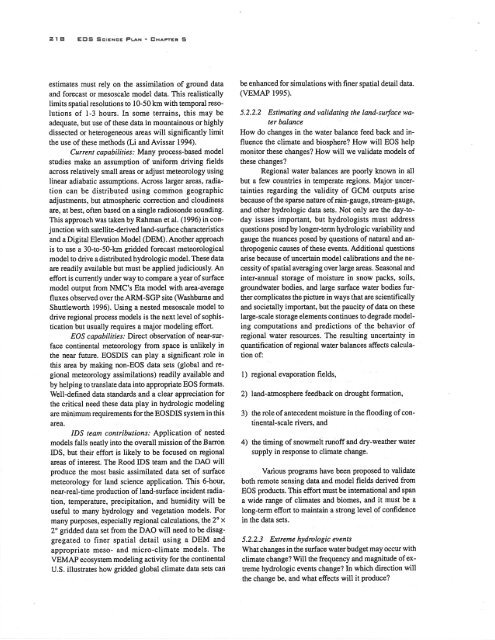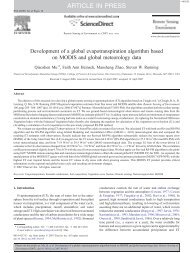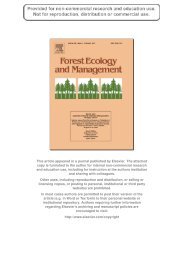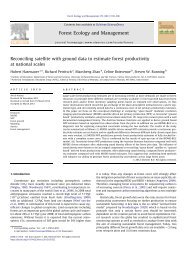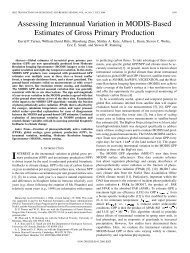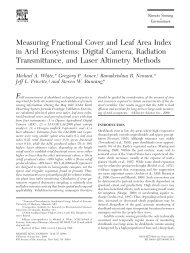Land_Ecosystems.pdf - S?TE
Land_Ecosystems.pdf - S?TE
Land_Ecosystems.pdf - S?TE
You also want an ePaper? Increase the reach of your titles
YUMPU automatically turns print PDFs into web optimized ePapers that Google loves.
21 6 EDS SCIENCE PLAN - CHAP<strong>TE</strong>R 6<br />
estimates must rely on the assimilation of ground data<br />
and forecast or mesoscale model data. This realistically<br />
limits spatial resolutions to 10-50 km with temporal reso<br />
lutions of 1-3 hours. In some terrains, this may be<br />
adequate, but use of these data in mountainous or highly<br />
dissected or heterogeneous areas will significantly limit<br />
the use of these methods (Li and Avissar 1994).<br />
Current capabilities: Many process-based model<br />
studies make an assumption of uniform driving fields<br />
across relatively small areas or adjust meteorology using<br />
linear adiabatic assumptions. Across larger areas, radia<br />
tion can be distributed using common geographic<br />
adjustments, but atmospheric correction and cloudiness<br />
are, at best, often based on a single radiosonde sounding.<br />
This approach was taken by Rahman et al. (1996) in con<br />
junction with satellite-derived land-surface characteristics<br />
and a Digital Elevation Model (DEM). Another approach<br />
is to use a 30-to-50-km gridded forecast meteorological<br />
model to drive a distributed hydrologic model. These data<br />
are readily available but must be applied judiciously. An<br />
effort is currently under way to compare a year of surface<br />
model output from NMC’s Eta model with area-average<br />
fluxes observed over the ARM-SGP site (Washburne and<br />
Shuttleworth 1996). Using a nested mesoscale model to<br />
drive regional process models is the next level of sophis<br />
tication but usually requires a major modeling effort.<br />
EOS capabilities: Direct observation of near-sur<br />
face continental meteorology from space is unlikely in<br />
the near future. EOSDIS can play a significant role in<br />
this area by making non-EOS data sets (global and re<br />
gional meteorology assimilations) readily available and<br />
by helping to translate data into appropriate EOS formats.<br />
Well-defined data standards and a clear appreciation for<br />
the critical need these data play in hydrologic modeling<br />
are minimum requirements for the EOSDIS system in this<br />
area.<br />
IDS team contributions: Application of nested<br />
models falls neatly into the overall mission of the Barron<br />
IDS, but their effort is likely to be focused on regional<br />
areas of interest. The Rood IDS team and the DAO will<br />
produce the most basic assimilated data set of surface<br />
meteorology for land science application. This 6-hour,<br />
near-real-time production of land-surface incident radia<br />
tion, temperature, precipitation, and humidity will be<br />
useful to many hydrology and vegetation models. For<br />
many purposes, especially regional calculations, the 2° x<br />
2° gridded data set from the DAO will need to be disag<br />
gregated to finer spatial detail using a DEM and<br />
appropriate meso- and micro-climate models. The<br />
VEMAP ecosystem modeling activity for the continental<br />
U.S. illustrates how gridded global climate data sets can<br />
be enhanced for simulations with finer spatial detail data.<br />
(VEMAP 1995).<br />
5.2.2.2 Estimating and validating the land-surface wa<br />
ter balance<br />
How do changes in the water balance feed back and in<br />
fluence the climate and biosphere? How will EOS help<br />
monitor these changes? How will we validate models of<br />
these changes?<br />
Regional water balances are poorly known in all<br />
but a few countries in temperate regions. Major uncer<br />
tainties regarding the validity of GCM outputs arise<br />
because of the sparse nature of rain-gauge, stream-gauge,<br />
and other hydrologic data sets. Not only are the day-to<br />
day issues important, but hydrologists must address<br />
questions posed by longer-term hydrologic variability and<br />
gauge the nuances posed by questions of natural and an<br />
thropogenic causes of these events. Additional questions<br />
arise because of uncertain model calibrations and the ne<br />
cessity of spatial averaging over large areas. Seasonal and<br />
inter-annual storage of moisture in snow packs, soils,<br />
groundwater bodies, and large surface water bodies fur<br />
ther complicates the picture in ways that are scientifically<br />
and societally important, but the paucity of data on these<br />
large-scale storage elements continues to degrade model<br />
ing computations and predictions of the behavior of<br />
regional water resources. The resulting uncertainty in<br />
quantification of regional water balances affects calcula<br />
tion of:<br />
1) regional evaporation fields,<br />
2) land-atmosphere feedback on drought formation,<br />
3) the role of antecedent moisture in the flooding of con<br />
tinental-scale rivers, and<br />
4) the timing of snowmelt runoff and dry-weather water<br />
supply in response to climate change.<br />
Various programs have been proposed to validate<br />
both remote sensing data and model fields derived from<br />
EOS products. This effort must be international and span<br />
a wide range of climates and biomes, and it must be a<br />
long-term effort to maintain a strong level of confidence<br />
in the data sets.<br />
5.2.2.3 Extreme hydrologic events<br />
What changes in the surface water budget may occur with<br />
climate change? Will the frequency and magnitude of ex<br />
treme hydrologic events change? In which direction will<br />
the change be, and what effects will it produce?


